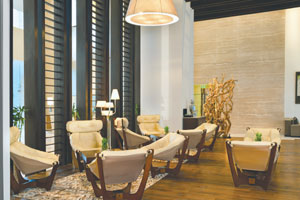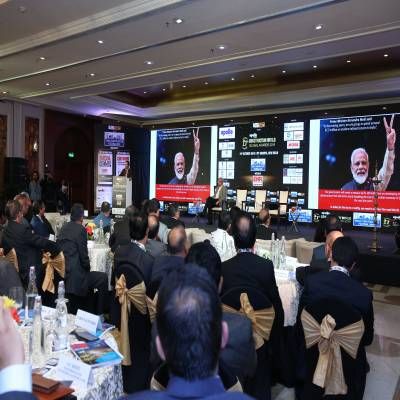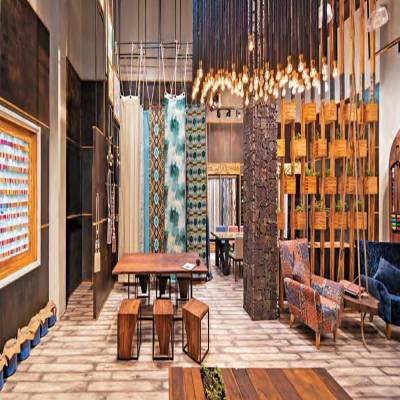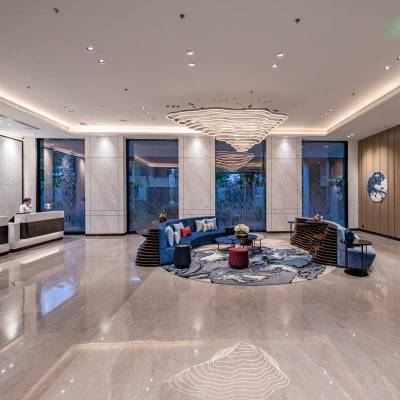
Hoteliers will have to differentiate their products better to survive
With the sector struggling to recover from a slump, can you update us with some current figures?
There has been a correction in rates over the past few years but good hotels continue to remain sold out in the season. The industry has experienced one of the worst quarters in many years. Hotels are struggling to make profit with high inflation and input costs and declining revenue.
Findings show that budget and mid-market hotels are making up a greater percentage of the total inventory and now make up almost half of all existing hotel rooms and close to 60 per cent of the country's future supply. In the past two decades, a demand drop has been witnessed only once in late 2008 owing to the collapse of the global economy following the Lehman debacle and then the terrorist attacks on Mumbai. Since then, demand has surged again owing to boisterous tourism.
What are the strategies adopted by Delhi hospitality players to stay afloat in the current economic scenario?
Delhi saw an influx of hotels being planned for the Commonwealth Games. Many of these hotels got delayed and have now recently come into the market. It will take some time for the market to absorb this inventory. The hospitality sector is expected to witness high growth over the long term. The next one or two years may be a phase of building before the high growth trajectory emerges. Several players are opting for the multi-location and multi-format strategy to expand their businesses. They are also looking to construct budget hotels and enter new product segments like serviced apartments, branded residences, etc.
How have rising construction costs affected the foray of real-estate players into the hospitality sector?
Rising costs and falling profits have forced many real-estate players to change course. Many companies have revisited their hospitality plans and are looking at efficient design or use of improved technology to bring operating costs down by saving energy.
How has the design of your recent project boosted its value?
The Baani and Hilton team have worked hard to translate the owners´ vision into reality. Consultants from all over the world were hired to build Hilton Garden Inn Gurgaon Baani Square. The design of a hotel plays a very important role in saving energy and manpower costs. Baani has been focussed in its approach on maintaining global standards in construction, fitment and delivering a superlative hospitality destination.
How about the overall investment in the deployment of rooms...
In any hotel in India the main cost is land. Apart from land, which greatly varies on location, most mid-market hotels are supposed to be built from Rs 35-60 lakh per key. The total cost of Hilton Garden Inn Gurgaon Baani Square has been Rs 55-60 lakh per key excluding land cost. The total built up area of the hotel is 210,000 sq ft.
You are primarily Delhi focussed. Any expansion plans?
We see enough potential in the NCR and will expand into other markets based on the right opportunity and good return on investment.
When we talk of hospitality developments, which areas according to you are the hot spots in India?
The highest concentration of branded rooms in the country can be found in Mumbai, Delhi and Bengaluru. Kolkata is the best performing hotel market in terms of occupancy. Mumbai shows the highest average rate and revenue per available room. Leading hotel brands have also pepped up their investments in India, both in metro and non-metro cities. Cities such as Hyderabad, Pune, Jaipur and Chandigarh have emerged as growing markets.
How do you view Gurgaon as a growing destination for the hospitality sector?
Gurgaon has seen unprecedented growth in terms of hotel room inventory. If you look at branded hotel rooms, they have moved from about 1,000 rooms to over 3,500 rooms in about 36 months. In fact, the number of hotel rooms the city has added may be higher than the added inventory for Delhi, Mumbai, Bengaluru and Kolkata combined. One of the reasons for this is that the land asset value in Gurgaon is much more reasonable and some builders already had land banks existing with them. It also benefits from proximity to the new international airport; the eight-lane expressway takes only 10 minutes to reach the heart of Gurgaon from the airport. This plays a key role in influencing both business and leisure travellers to stay here and Baani Hospitality has been strategically planned along these growth corridors of Gurgaon. Bolstering this is also the fact that Gurgaon has a plethora of vibrant shopping malls and a lively restaurant culture.
What is your outlook on the future of India´s real-estate hospitality sector?
Going ahead, as the market matures further and more hotels open, it will be important to know that only differentiated products will work in a market, which is now getting slightly over-supplied. Hoteliers will have to differentiate their products better to survive. Baani Hospitality is enthusiastically working and pitching on differentiated hospitality models that not only include the conventional stay at hotel premises but bring in concepts of condotels and residences within the hotel community. Very soon, we will announce a strategic tie-up with a leading international brand to develop hotel-managed residences that allow the residents to enjoy all the comforts and convenience of living in their property managed by the hotel. We think this high-life living concept will take luxury residence living to the next level. We are gearing up to stay ahead of the wave coming our way to bolster growth in the hospitality real-estate space.
- Supply of rooms in the organised sector: 93,000 (end of 2012-13).
- More than 50,000 branded rooms to be developed over the next
- five years.
- Highest branded rooms concentration: Mumbai, Delhi and Bengaluru.
- Hotel rooms growth in Gurgaon: 1,000 rooms to over 3,500 rooms in 36 months.
The Indian hospitality industry, which has witnessed strong headwinds for the past year, is slowly inching towards optimum growth. According to the India Trends and Opportunities Report by HVS Global Hospitality Services, India's supply of rooms in the organised sector has almost quadrupled to over 93,000 at the end of 2012-13, from about 25,000 in 2000-01. Adding to these figures, Virendra Bhatia, President, Baani Group, which has recently diversified in the hospitality sector with Hilton Garden Inn Gurgaon Baani Square, says, ´More than 50,000 branded rooms will be developed over the next five years, taking the total supply to about 144,000 rooms by 2017-18.ö Taking this point further, he shares with CW PROPERTY TODAY his view on the growing hospitality industry. With the sector struggling to recover from a slump, can you update us with some current figures? There has been a correction in rates over the past few years but good hotels continue to remain sold out in the season. The industry has experienced one of the worst quarters in many years. Hotels are struggling to make profit with high inflation and input costs and declining revenue. Findings show that budget and mid-market hotels are making up a greater percentage of the total inventory and now make up almost half of all existing hotel rooms and close to 60 per cent of the country's future supply. In the past two decades, a demand drop has been witnessed only once in late 2008 owing to the collapse of the global economy following the Lehman debacle and then the terrorist attacks on Mumbai. Since then, demand has surged again owing to boisterous tourism. What are the strategies adopted by Delhi hospitality players to stay afloat in the current economic scenario? Delhi saw an influx of hotels being planned for the Commonwealth Games. Many of these hotels got delayed and have now recently come into the market. It will take some time for the market to absorb this inventory. The hospitality sector is expected to witness high growth over the long term. The next one or two years may be a phase of building before the high growth trajectory emerges. Several players are opting for the multi-location and multi-format strategy to expand their businesses. They are also looking to construct budget hotels and enter new product segments like serviced apartments, branded residences, etc. How have rising construction costs affected the foray of real-estate players into the hospitality sector? Rising costs and falling profits have forced many real-estate players to change course. Many companies have revisited their hospitality plans and are looking at efficient design or use of improved technology to bring operating costs down by saving energy. How has the design of your recent project boosted its value? The Baani and Hilton team have worked hard to translate the owners´ vision into reality. Consultants from all over the world were hired to build Hilton Garden Inn Gurgaon Baani Square. The design of a hotel plays a very important role in saving energy and manpower costs. Baani has been focussed in its approach on maintaining global standards in construction, fitment and delivering a superlative hospitality destination. How about the overall investment in the deployment of rooms... In any hotel in India the main cost is land. Apart from land, which greatly varies on location, most mid-market hotels are supposed to be built from Rs 35-60 lakh per key. The total cost of Hilton Garden Inn Gurgaon Baani Square has been Rs 55-60 lakh per key excluding land cost. The total built up area of the hotel is 210,000 sq ft. You are primarily Delhi focussed. Any expansion plans? We see enough potential in the NCR and will expand into other markets based on the right opportunity and good return on investment. When we talk of hospitality developments, which areas according to you are the hot spots in India? The highest concentration of branded rooms in the country can be found in Mumbai, Delhi and Bengaluru. Kolkata is the best performing hotel market in terms of occupancy. Mumbai shows the highest average rate and revenue per available room. Leading hotel brands have also pepped up their investments in India, both in metro and non-metro cities. Cities such as Hyderabad, Pune, Jaipur and Chandigarh have emerged as growing markets. How do you view Gurgaon as a growing destination for the hospitality sector? Gurgaon has seen unprecedented growth in terms of hotel room inventory. If you look at branded hotel rooms, they have moved from about 1,000 rooms to over 3,500 rooms in about 36 months. In fact, the number of hotel rooms the city has added may be higher than the added inventory for Delhi, Mumbai, Bengaluru and Kolkata combined. One of the reasons for this is that the land asset value in Gurgaon is much more reasonable and some builders already had land banks existing with them. It also benefits from proximity to the new international airport; the eight-lane expressway takes only 10 minutes to reach the heart of Gurgaon from the airport. This plays a key role in influencing both business and leisure travellers to stay here and Baani Hospitality has been strategically planned along these growth corridors of Gurgaon. Bolstering this is also the fact that Gurgaon has a plethora of vibrant shopping malls and a lively restaurant culture. What is your outlook on the future of India´s real-estate hospitality sector? Going ahead, as the market matures further and more hotels open, it will be important to know that only differentiated products will work in a market, which is now getting slightly over-supplied. Hoteliers will have to differentiate their products better to survive. Baani Hospitality is enthusiastically working and pitching on differentiated hospitality models that not only include the conventional stay at hotel premises but bring in concepts of condotels and residences within the hotel community. Very soon, we will announce a strategic tie-up with a leading international brand to develop hotel-managed residences that allow the residents to enjoy all the comforts and convenience of living in their property managed by the hotel. We think this high-life living concept will take luxury residence living to the next level. We are gearing up to stay ahead of the wave coming our way to bolster growth in the hospitality real-estate space. Supply of rooms in the organised sector: 93,000 (end of 2012-13). More than 50,000 branded rooms to be developed over the next five years. Highest branded rooms concentration: Mumbai, Delhi and Bengaluru. Hotel rooms growth in Gurgaon: 1,000 rooms to over 3,500 rooms in 36 months.





















